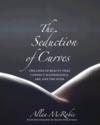- About MAA
- Membership
- MAA Publications
- Periodicals
- Blogs
- MAA Book Series
- MAA Press (an imprint of the AMS)
- MAA Notes
- MAA Reviews
- Mathematical Communication
- Information for Libraries
- Author Resources
- Advertise with MAA
- Meetings
- Competitions
- Programs
- Communities
- MAA Sections
- SIGMAA
- MAA Connect
- Students
- MAA Awards
- Awards Booklets
- Writing Awards
- Teaching Awards
- Service Awards
- Research Awards
- Lecture Awards
- Putnam Competition Individual and Team Winners
- D. E. Shaw Group AMC 8 Awards & Certificates
- Maryam Mirzakhani AMC 10 A Awards & Certificates
- Two Sigma AMC 10 B Awards & Certificates
- Jane Street AMC 12 A Awards & Certificates
- Akamai AMC 12 B Awards & Certificates
- High School Teachers
- News
You are here
The Seduction of Curves: The Lines of Beauty That Connect Mathematics, Art, and the Nude

Publisher:
Princeton University Press
Publication Date:
2017
Number of Pages:
168
Format:
Hardcover
Price:
35.00
ISBN:
9780691175331
Category:
General
[Reviewed by , on ]
Mark Hunacek
08/29/2017
Over the years, my association with this column has given me the opportunity to review books on all sorts of topics in mathematics, from undergraduate and graduate texts on (among other things) algebra, analysis, topology, and differential equations to less standard fare on such topics as a game-theoretic look at the efficacy of torture. But I have never encountered anything quite like the book now under review, which I view as genuinely sui generis. In what other book, for example, is one likely to encounter a picture of the Boy’s Surface on one page, and a picture of a nude on another?
The idea behind this book is to explore certain kinds of curves and the varied ways in which they show up in a whole host of different contexts. The curves that are studied come from catastrophe theory; in particular, special attention is paid to curves that correspond to the so-called Seven Elementary Catastrophes articulated by René Thom, the founder of the subject. These seven include four from the cuspoid family (fold, cusp, swallowtail and butterfly) and three from the umbilic family (elliptic, hyperbolic and parabolic).
These seven curves, we are told, are “the basic building blocks, the fundamental components of curved form.” They “also represent a way by which something can suddenly change.” This is, of course, the essence of catastrophe theory, which (very roughly speaking) studies how smooth changes in a system can result in sudden and abrupt outputs. (Slowly raising the temperature on a kettle of water suddenly causes it to boil, for example.)
There is genuine mathematical content here, but it is not the intent of the book to teach catastrophe theory. Rather, the book is concerned with illustrating the ubiquity of these seven curves, both in art and elsewhere. The book does not employ a theorem/proof format and does not try to generally define terms in a rigorous way. The emphasis throughout is on visual observation, informed by “catastrophe-aware eyes”. To this end, the (excellent) prose descriptions are accompanied by lots of illustrations, both photographs and drawings, quite a few of which are in color.
The pervasiveness of these curves is striking. The book discusses, for example, how they show up in optics, relativity, rainbows, engineering (chapter 5, for example, relates the butterfly cuspoid to the stability of oil rigs), anatomy (the nude human body contains lots of these curves, and the author tells us that Thom even devoted part of a mathematics book to a discussion of “the age-old question of the shape of the genitals”) and art. Special attention is given to the work of certain artists, such as Salvador Dali and Naum Gabo; each of these artists is the subject of a chapter in the text. Naum Gabo was new to me, and while I had certainly heard of Dali, I had no idea that he was influenced by catastrophe theory, and certainly did not know that he had stated that a “more aesthetic notion than the latest theory of Catastrophes by René Thom is still to be found… [it] has bewitched all of my atoms since I first heard about it.”
In addition to the chapters on Gabo and Dali, there is a one-chapter “mathography” of Thom himself. Described by the author as “easily the most difficult chapter to write”, this focuses on catastrophe theory, criticism of some of its applications, and its relationship to other theories such as postmodernism, large portions of which the author describes as gibberish. This chapter, by itself, provides an interesting supplement to any serious mathematical study of catastrophe theory.
To summarize: clearly, this is not a book that can be used as a text for any kind of conventional mathematics course. It is, however, an unusual and eclectic book, and one that taught me a lot of things that I did not know before.
Mark Hunacek (mhunacek@iastate.edu) teaches mathematics at Iowa State University.
1 The Alphabet of Beautiful Curves 1
2 The Fold 5
3 The Cusp 14
4 The Swallowtail 22
5 The Butterfly 31
6 The Wigwam 35
7 Lips, Beaks, Gull, Goose 37
8 The Persistence of Cusps 43
9 Moiré and Dupin 47
10 The Umbilics 61
11 Catastrophe Optics 67
12 The Rainbow 73
13 Gravitational Lenses 77
14 Stability 85
15 Morphogenesis 88
16 Gabo 94
17 The Pregnance of Curves 117
18 Thom 125
19 Dalí 135
Notes 147
Bibliography 151
Image Credits 153
Index 157
- Log in to post comments




